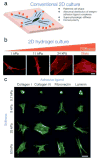A practical guide to hydrogels for cell culture
- PMID: 27123816
- PMCID: PMC5800304
- DOI: 10.1038/nmeth.3839
A practical guide to hydrogels for cell culture
Abstract
There is growing appreciation of the role that the extracellular environment plays in regulating cell behavior. Mechanical, structural, and compositional cues, either alone or in concert, can drastically alter cell function. Biomaterials, and particularly hydrogels, have been developed and implemented to present defined subsets of these cues for investigating countless cellular processes as a means of understanding morphogenesis, aging, and disease. Although most scientists concede that standard cell culture materials (tissue culture plastic and glass) do a poor job of recapitulating native cellular milieus, there is currently a knowledge barrier for many researchers in regard to the application of hydrogels for cell culture. Here, we introduce hydrogels to those who may be unfamiliar with procedures to culture and study cells with these systems, with a particular focus on commercially available hydrogels.
Conflict of interest statement
The authors declare no competing financial interests.
Figures


Similar articles
-
Hydrogels for in vivo-like three-dimensional cellular studies.Wiley Interdiscip Rev Syst Biol Med. 2012 Jul-Aug;4(4):351-65. doi: 10.1002/wsbm.1174. Epub 2012 May 21. Wiley Interdiscip Rev Syst Biol Med. 2012. PMID: 22615143 Review.
-
Biochemical and structural characterization of neocartilage formed by mesenchymal stem cells in alginate hydrogels.PLoS One. 2014 Mar 13;9(3):e91662. doi: 10.1371/journal.pone.0091662. eCollection 2014. PLoS One. 2014. PMID: 24626259 Free PMC article.
-
Dynamic hydrogels: switching of 3D microenvironments using two-component naturally derived extracellular matrices.Adv Mater. 2010 Feb 9;22(6):686-91. doi: 10.1002/adma.200902265. Adv Mater. 2010. PMID: 20217770 No abstract available.
-
Biochemical and physical signal gradients in hydrogels to control stem cell behavior.Adv Mater. 2013 Nov 26;25(44):6366-72. doi: 10.1002/adma.201302364. Epub 2013 Aug 25. Adv Mater. 2013. PMID: 23983019 Free PMC article.
-
Engineering hydrogels as extracellular matrix mimics.Nanomedicine (Lond). 2010 Apr;5(3):469-84. doi: 10.2217/nnm.10.12. Nanomedicine (Lond). 2010. PMID: 20394538 Free PMC article. Review.
Cited by
-
Microscopy-guided laser ablation for the creation of complex skin models with folliculoid appendages.Bioeng Transl Med. 2020 Dec 15;6(2):e10195. doi: 10.1002/btm2.10195. eCollection 2021 May. Bioeng Transl Med. 2020. PMID: 34027085 Free PMC article.
-
Effects of Netarsudil-Family Rho Kinase Inhibitors on Human Trabecular Meshwork Cell Contractility and Actin Remodeling Using a Bioengineered ECM Hydrogel.Front Ophthalmol (Lausanne). 2022 Jul 15;2:948397. doi: 10.3389/fopht.2022.948397. eCollection 2022. Front Ophthalmol (Lausanne). 2022. PMID: 38983571 Free PMC article.
-
Dynamic Covalent Polymers for Biomedical Applications.Mater Chem Front. 2020 Feb 1;4(2):489-506. doi: 10.1039/c9qm00598f. Epub 2019 Dec 3. Mater Chem Front. 2020. PMID: 33791102 Free PMC article.
-
Exploring the potential of in vitro extracellular vesicle generation in reproductive biology.J Extracell Biol. 2024 Sep 5;3(9):e70007. doi: 10.1002/jex2.70007. eCollection 2024 Sep. J Extracell Biol. 2024. PMID: 39238549 Free PMC article. Review.
-
Applications of Biomaterials in 3D Cell Culture and Contributions of 3D Cell Culture to Drug Development and Basic Biomedical Research.Int J Mol Sci. 2021 Mar 2;22(5):2491. doi: 10.3390/ijms22052491. Int J Mol Sci. 2021. PMID: 33801273 Free PMC article. Review.
References
-
- Baker BM, Chen CS. Deconstructing the third dimension – how 3D culture microenvironments alter cellular cues. Journal of Cell Science. 2012;125:3015–3024. This review elegantly discusses the critical factors such as adhesion, mechanics, and nutrient transport that make 3D cultures different from cell experiments on 2D substrates. - PMC - PubMed
-
- Lutolf MP, Hubbell JA. Synthetic biomaterials as instructive extracellular microenvironments for morphogenesis in tissue engineering. Nat Biotechnol. 2005;23:47–55. - PubMed
Publication types
MeSH terms
Substances
Grants and funding
LinkOut - more resources
Full Text Sources
Other Literature Sources

